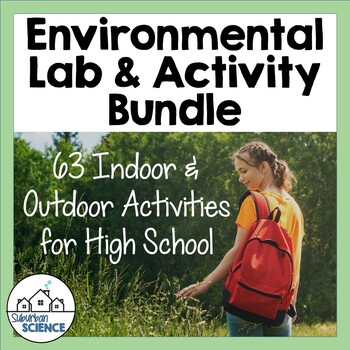Environmental Science Lab and Activity Bundle for High School
- Zip
Products in this Bundle (19)
showing 1-5 of 19 products
Bonus
Description
Looking for hands-on labs and activities for a high school Environmental Science course? This bundle contains 63 thorough and engaging projects, indoor and outdoor labs, activities, and experiments for hands-on learning! The environmental labs and activities included in this bundle are designed to be easy to use and aligned to many state and NGSS standards.
Field activities, group projects, games, discussions, inquiry labs, and research projects are all included! Many activities also have student worksheets that are perfect for lab notebooks. Click on the preview to view these activities.
Save yourself prep time now and for the years to come. Teacher instructions, materials lists, and student worksheets are all ready to go!
By purchasing this bundle, you save more than 20% and will also receive all future activities that I create for my Full Environmental Science Curriculum FOR FREE.
*Please NOTE: These activities can be found in each of my individual environmental units and in the Full Environmental Science Curriculum. You can find each unit at the end of this description.
What's included?
-21 Group or Independent Research Activities
-8 Outdoor Labs
-13 Group Projects
-9 Whole-Class Activities
-6 Inquiry Labs
Student favorites include: Build an Aquifer Model, Soil Analysis Lab, Edible Mining Simulation, Electric Generator STEAM Lab, and Personal Water Audit!
*Click on each included activity for a preview.
➤Teaching virtually?
-These activities also include digital student worksheets in a Google Slides format for students to type on with a device in distance learning environments or 1:1 classrooms.
*Please note: These are digital worksheets, not virtual labs. They will not replace the labs done in the classroom.
➤Looking for more than just labs? The following Environmental Science units include the labs in this bundle as well as PowerPoint presentations, webquests, Cornell notes, Doodle notes, review materials, and assessments.
-Introduction to Environmental Science
-Biosphere Unit 1: Ecology, Food Webs, Symbiosis, Earth's Spheres
-Biosphere Unit 2: Species & Population Growth
-Biosphere Unit 3: World Biomes, Ecological Succession & Biodiversity
-Atmosphere Unit: Global Winds, Weather, Biogeochemical Cycles
-Geosphere Unit 1: Plate Tectonics
-Geosphere Unit 2: Minerals, Mining, & Soil
-Geosphere Unit 3: Fossil Fuels & Renewable Energy
-Hydrosphere Unit 1: Surface Water & Groundwater
-Hydrosphere Unit 2: Marine Biomes & Water Pollution
-Land Use & Sustainability Unit
OR get the Full Environmental Science curriculum for 20% off!
______________________________________________________________
⭐For updates about sales and new products, please follow my store: My TpT Store
You can also
⭐Subscribe to my newsletter for freebies and teaching tips
⭐Follow me on Instagram
⭐Check out my Facebook page
⭐Follow me on Pinterest
I value your feedback. Please rate this product. If you have any issues or questions about this product, please feel free to ask a question in my store or write to me at support@suburbanscience.com.




